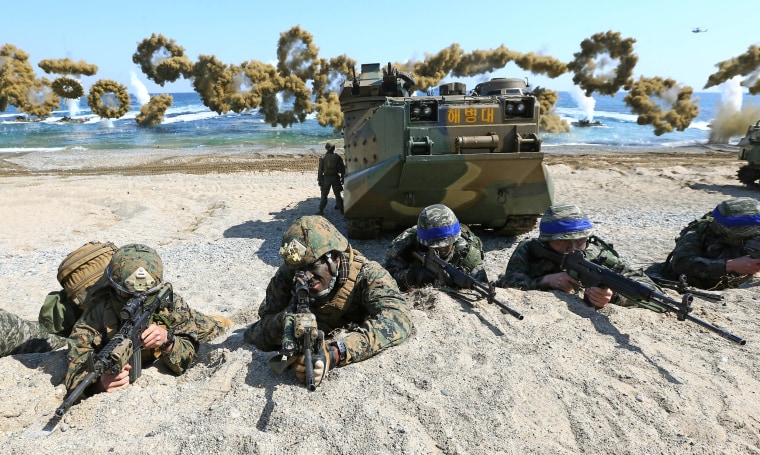The U.S. military is preparing to announce that annual large-scale joint exercises conducted with South Korea every spring will no longer be held, according to two U.S. defense officials.
The major U.S.-South Korea exercises are being curtailed as part of the Trump administration's effort to ease tensions with North Korea, the officials said. The exercises — known as Key Resolve and Foal Eagle — will be replaced with smaller, mission-specific training, according to the officials.
Since taking office, President Donald Trump has repeatedly complained about the large-scale exercises, saying they're too costly and the U.S. bears too much of the financial burden.
The military has carried out the major exercises as much for deterring the North Korean regime as maintaining troop readiness, according to senior defense officials.
A U.S. official said military leadership is now working out how a series of smaller exercises and upcoming training can be used to ensure troop readiness. With the advancement of technology, some of the training can be done virtually and no longer requires thousands of troops, according to defense officials.
"The U.S. has identified ways to mitigate potential readiness concerns by looking at required mission tasks versus having to conduct large-scale exercises," one defense official said.
But some experts on North Korea questioned whether the major exercises can be suspended without significantly affecting the troops' ability to combat threats.
“That would run counter to what the military has been saying for decades,” said Bruce Klingner, a former CIA officer who tracked North Korea and is now a senior fellow at the Heritage Foundation. “Militaries need to train.”
“If you continue curtailing your exercises, on what day has it reached catastrophic proportions?" Klingner added. "It's hard to measure. But you know, over time, there has to be a degradation."
U.S. officials insist the exercises and scenarios need to adapt to adjust to the changing situation in the region. A Pentagon spokesman declined to comment.
Word of the planned announcement comes less than 48 hours after a summit between Trump and North Korean leader Kim Jong Un came to an abrupt end with no agreement. Trump said afterward that the annual military drills with South Korea were "very, very expensive" and the government in Seoul should pay more for them.
U.S. officials said the decision is not related to the summit in Hanoi but has been under consideration for some time.
Following his first summit with Kim in Singapore last June, Trump announced that the U.S. would suspend large-scale joint military exercises, but smaller exercises and training have continued.
While the U.S. has pulled back on its exercises, North Korea has pressed ahead with its own drills. Gen. Robert Abrams, commander of U.S. forces in Korea, recently testified that North Korea was preparing to carry out its annual winter cycle of training with 1 million troops.
A South Korean government official said the larger exercises have gained a lot of media attention in the past and South Korea is “trying to carry on as usual with a very low-key media vibes."
"In this context, we are changing and changed the names of these drills," the official said.
The Key Resolve exercise is held in March and runs for about two weeks, overlapping with Foal Eagle, which runs for about a month. These annual exercises involve thousands of troops, with ground, air and naval forces from the United States and South Korea, as well as contingents from Australia, Britain, France and other countries.
The exercises coincide with the rotation of South Korea troops, whose annual assignments changeover at that point, said Bruce Bennett, senior defense researcher at the Rand Corp., a think tank.
Military planners have long considered March to be the most likely time for any potential North Korean invasion, when the ground is still hard from winter to allow tanks to roll through rice fields and North Koreans troops have just completed their annual winter training cycle, Bennett said.
The joint U.S. exercises, including Key Resolve and others, allow officers to find weaknesses in a war plan and make adjustments, as well as cultivate a rapport with counterparts from South Korea and other allies, Bennett said.
“The exercises are something that doesn’t cost a great deal but that yield a substantial return in terms of training and developing relationships (with allies)," Bennett said.
“In terms of deterrence with North Korea, this is one of the ways we demonstrate that we are hanging together with our allies. One of North Korea’s major objectives is splitting the alliance and getting the U.S. off the peninsula, and canceling the exercises is one stop in that direction.”
Joint military exercises are often terminated for a number of reasons, including changes to security situations or when certain levels of readiness are met, officials said.
At the first Trump-Kim summit, the president blindsided his secretary of defense at the time, Jim Mattis, U.S. commanders and South Korea and Japan when he announced that joint exercises would be called off.
The U.S. and South Korea have since canceled a total of nine military exercises and scaled back others, according to Klingner.
“That’s not good alliance management," Klingner said. “We didn’t get anything in return. North Korea did not codify their missile test moratorium, nor do they agree to any constraints on their own military operations.”

